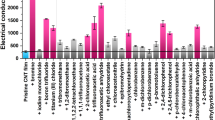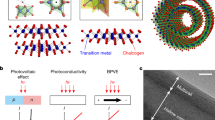Abstract
The fundamental mechanism underlying photocurrent generation in carbon nanotubes1,2,3 has long been an open question. In photocurrent generation, the temperature of the photoexcited charge carriers determines the transport regime by which the electrons and holes are conducted through the nanotube. Here, we identify two different photocurrent mechanisms for metallic and semiconducting carbon nanotube devices with induced p–n junctions4,5,6,7. Our photocurrent measurements as a function of charge carrier doping demonstrate a thermal origin8,9 for metallic nanotubes, where photo-excited hot carriers give rise to a current. For semiconducting nanotubes we demonstrate a photovoltaic mechanism10,11,12, where a built-in electric field results in electron–hole separation. Our results provide an understanding of the photoresponse in carbon nanotubes, which is not only of fundamental interest but also of importance for designing carbon-based, high-efficiency photodetectors and energy-harvesting devices.
This is a preview of subscription content, access via your institution
Access options
Subscribe to this journal
Receive 12 print issues and online access
$209.00 per year
only $17.42 per issue
Buy this article
- Purchase on Springer Link
- Instant access to full article PDF
Prices may be subject to local taxes which are calculated during checkout




Similar content being viewed by others
References
Biercuk, M. J., Ilani, S., Marcus, C. M. & McEuen, P. L. Electrical transport in single-walled carbon nanotubes. Top. Appl. Phys. 111, 455–493 (2008).
Dresselhaus, M. S., Dresselhaus, G., Charlier, J. C. & Hernandez, E. Electronic, thermal and mechanical properties of carbon nanotubes. Phil. Trans. R. Soc. Lond. A 362, 2065–2098 (2004).
Dresselhaus, M. S., Dresselhaus, G., Saito, R. & Jorio, A. Exciton photophysics of carbon nanotubes. Annu. Rev. Phys. Chem. 58, 719–747 (2007).
Freitag, M., Martin, Y., Misewich, J. A., Martel, R. & Avouris, P. H. Photoconductivity of single carbon nanotubes. Nano Lett. 3, 1067–1071 (2003).
Gabor, N. M., Zhong, Z., Bosnick, K., Park, J. & McEuen, P. L. Extremely efficient multiple electron–hole pair generation in carbon nanotube photodiodes. Science 325, 1367–1371 (2009).
Lee, J. U., Gipp, P. P. & Heller, C. M. Carbon nanotube p–n junction diodes. Appl. Phys. Lett. 85, 145–147 (2004).
Barkelid, M., Steele, G. A. & Zwiller, V. Probing optical transitions in individual carbon nanotubes using polarized photocurrent spectroscopy. Nano Lett. 12, 5649–5653 (2012).
St-Antoine, B. C., Menard, D. & Martel, R. Position sensitive photothermoelectric effect in suspended single-walled carbon nanotube films. Nano Lett. 9, 3503–3508 (2009).
Tsen, A. W., Donev, L. A. K., Kurt, H., Herman, L. H. & Park, J. Imaging the electrical conductance of individual carbon nanotubes with photothermal current microscopy. Nature Nanotech. 4, 108–113 (2008).
Balasubramanian, K., Burghard, M., Kern, K., Scolari, M. & Mews, A. Photocurrent imaging of charge transport barriers in carbon nanotube devices. Nano Lett. 5, 507–510 (2005).
Ahn, Y. H., Tsen, A. W., Kim, B., Park, Y. W. & Park, J. Photocurrent imaging of p–n junctions in ambipolar carbon nanotube transistors. Nano Lett. 7, 3320–3323 (2007).
Balasubramanian, K., Fan, Y., Burghard, M. & Kern, K. Photoelectronic transport imaging of individual semiconducting carbon nanotubes. Appl. Phys. Lett. 84, 2400 (2004).
Mueller, T. et al. Efficient narrow-band light emission from a single carbon nanotube p–n diode. Nature Nanotech. 5, 27–31 (2010).
Barone, P. W., Baik, S., Heller, D. A. & Strano, M. S. Near-infrared optical sensors based on single-walled carbon nanotubes. Nature Mater. 4, 86–92 (2005).
Lee, J. U. Photovoltaic effect in ideal carbon nanotube diodes. Appl. Phys. Lett. 87, 073101 (2005).
Song, J. C. W., Rudner, M. S., Marcus, C. M. & Levitov, L. S. Hot carrier transport and photocurrent response in graphene. Nano Lett. 11, 4688–4692 (2011).
Gabor, N. M. et al. Hot carrier-assisted intrinsic photoresponse in graphene. Science 334, 648–652 (2011).
Sun, D. et al. Ultrafast hot-carrier-dominated photocurrent in graphene. Nature Nanotech. 7, 114–118 (2012).
Buchs, G., Barkelid, M., Bagiante, S., Steele, G. A. & Zwiller, V. Imaging the formation of a p–n junction in a suspended carbon nanotube with scanning photocurrent microscopy. J. Appl. Phys. 110, 074308 (2011).
Pop, E. et al. Negative differential conductance and hot phonons in suspended nanotube molecular wires. Phys. Rev. Lett. 95, 155505 (2005).
Strait, J. H. et al. Very slow cooling dynamics of photoexcited carriers in graphene observed by optical-pump terahertz-probe spectroscopy. Nano Lett. 11, 4902–4906 (2011).
Small, J. P., Perez, K. M. & Kim, P. Modulation of thermoelectric power of individual carbon nanotubes. Phys. Rev. Lett. 91, 256801 (2003).
Perebeinos, V. & Avouris, P. Impact excitation by hot carriers in carbon nanotubes. Phys. Rev. B 74, 121410 (2006).
Tielrooj, K. J. et al. Photoexcitation cascade and multiple hot-carrier generation in graphene. Nature Phys. 9, 248–252 (2013).
Freitag, M., Low, T., Xia, F. & Avouris, P. Photoconductivity of biased graphene. Nature Photon. 7, 53–59 (2013).
Freitag, M., Low, T. & Avouris, P. Increased responsivity of suspended graphene photodetectors. Nano Lett. 13, 1644–1648 (2013).
Sze, S. M. Semiconductor Devices Physics and Technology 225–237 (Wiley, 2002).
Ross, R. T. & Nozik, A. J. Efficiency of hot-carrier solar energy converters. J. Appl. Phys. 53, 3813–3818 (1982).
Omari, M. & Kouklin, N. A. Photothermovoltaic effect in carbon nanotubes: en route toward junctionless infrared photocells and light sensors. Appl. Phys. Lett. 98, 243113 (2011).
Kong, J., Soh, H. T., Cassell, A. M., Quate, C. F. & Dai, H. Synthesis of individual single-walled carbon nanotubes on patterned silicon wafers. Nature 395, 878–881 (1998).
Acknowledgements
This research was supported by the Dutch Foundation for Fundamental Research on Matter (FOM). The authors would like to thank M.S. Rudner for discussions.
Author information
Authors and Affiliations
Contributions
M.B. fabricated the devices, performed the measurements and wrote the manuscript. V.Z. supervised the project. All authors discussed the results and commented on the manuscript.
Corresponding author
Ethics declarations
Competing interests
The authors declare no competing financial interests.
Supplementary information
Supplementary information
Supplementary information (PDF 1201 kb)
Rights and permissions
About this article
Cite this article
Barkelid, M., Zwiller, V. Photocurrent generation in semiconducting and metallic carbon nanotubes. Nature Photon 8, 47–51 (2014). https://doi.org/10.1038/nphoton.2013.311
Received:
Accepted:
Published:
Issue Date:
DOI: https://doi.org/10.1038/nphoton.2013.311
This article is cited by
-
Direct observation of significant hot carrier cooling suppression in a two-dimensional silicon phononic crystal
NPG Asia Materials (2022)
-
Photocurrent response in few-layered ReS2 devices with short and open circuits
Journal of the Korean Physical Society (2022)
-
Unidirectional ion transport in nanoporous carbon membranes with a hierarchical pore architecture
Nature Communications (2021)
-
Progress in light-to-frequency conversion circuits based on low dimensional semiconductors
Nano Research (2021)
-
Giant photothermoelectric effect in silicon nanoribbon photodetectors
Light: Science & Applications (2020)



